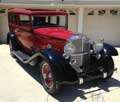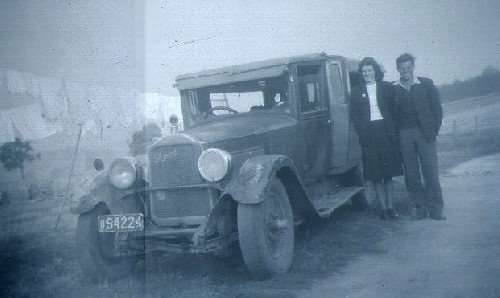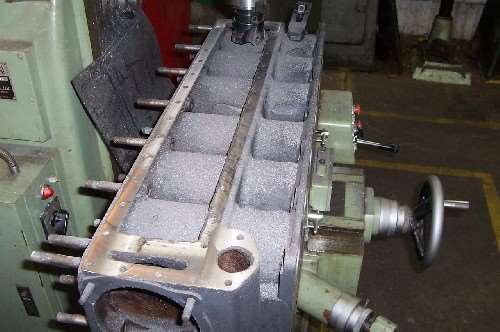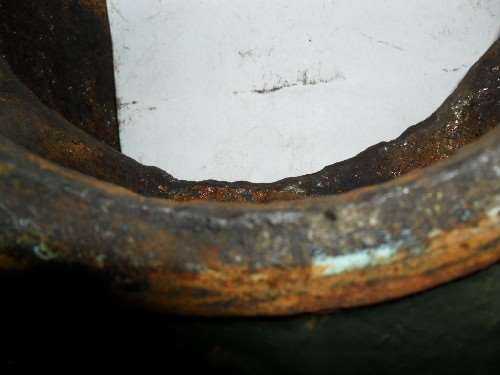|
Re: Packard engine coolant
|
||||
|---|---|---|---|---|
|
Quite a regular
|
Thanks guys for all the ideas put forth so far.
I need to fill in some gaps about the motor. It has had a major overhaul. New pistons, valves, main and big end bearings,valve guides,cylinders re-bored and one re-sleeved.The side water jacket was renewed.A new honeycomb radiator fitted. Coil has been rewound. New timing chain and the sump repaired. About the only thing that has let the job down is the condition of the cooling system. When I first drove it for the registration inspection it "vomited" for want of a better word and mud went everywhere - thick enough to appear like custard or jam. I have cleaned and flushed the system and have tried some coolant additive that lowers the water surface tension and lowers the running temperature by a few degrees. This has helped but not completely. I think the head especially is still quite dirty inside although not much debris or colour appears after a flush. Couple of extra pics. My folks with the Packard during their courting days about 1948. The engine block having the water jacket surface machined.
Posted on: 2015/2/7 6:22
|
|||
|
||||
|
Re: Packard engine coolant
|
||||
|---|---|---|---|---|
|
Forum Ambassador

|
Was the new radiator core flow-rate tested before installation to insure it had proper capacity? "Vomiting" strongly suggests insufficient flow rate thru the radiator; although it was new and clean when installed the honeycomb radiators are easily plugged/restricted by debris and perhaps it clogged again from residual crap in the system. My best suggestion is to have the radiator flow-rate tested.
Can we assume that when the engine was rebuilt the block was hot-tanked thoroughly and perhaps the internal water jacket surfaces bead or sand blasted to insure complete cleanliness? It sounds like that was not done or not done adequately if on startup with a new radiator you had so much debris in the cooling system.
Posted on: 2015/2/7 10:52
|
|||
|
||||
|
Re: Packard engine coolant
|
||||
|---|---|---|---|---|
|
Home away from home

|
After reading what has been done to the block & radiator they seem an unlikely source for the "mud". Could the head have been the source of the rusty debris that has probably worked it's way throughout the entire cooling system?
At this point, I think I would remove the radiator and back flush it. Then do a flow test. There was a recent posting on this subject within the last two months or so. I would then try to hook up a water hose to the engine and back flush it with water before installing the radiator. I'm not sure if an oxalic acid treatment (followed with a sodium bicarbonate neutralization step) would be in order or not, which should take care of a minor rust problem.
Posted on: 2015/2/7 19:19
|
|||
|
||||
|
Re: Packard engine coolant
|
||||
|---|---|---|---|---|
|
Quite a regular
|
Just an update on the cooling problem and thanks to all the comments - they are most welcome.
I tried a flush with CLR which is a phosphoric acid based cleaner for domestic cleaning. It removed a great deal of rusty sediment. I then flushed the motor and did a clean with a normal alkali based cleaner. The next outing in the car produced some boilover but not too severe and only when going up hill. I also checked the water pump endplay and it is significant. Next job is to refurbish the pump as I suspect it is not working to its capacity. 
Posted on: 2015/2/15 20:29
|
|||
|
||||
|
Re: Packard engine coolant
|
||||
|---|---|---|---|---|
|
Forum Ambassador

|
Next job is to refurbish the pump as I suspect it is not working to its capacity.
Pay particular attention to the impellor to housing clearance; pump capacity on centrifugal pumps falls off very rapidly as the clearance increases.
Posted on: 2015/2/15 23:22
|
|||
|
||||
|
Re: Packard engine coolant
|
||||
|---|---|---|---|---|
|
Home away from home

|
Anyone suggested Exh Gas blowing into the coolant?
Gasket - head torque - surface - crack. Ive also seen them run hot when their bored out to far; thin wall. Nowadays, with time attacking the coolant side of the cyl., sleeving is getting to b a must.
Posted on: 2015/2/16 9:24
|
|||
|
||||
|
Re: Packard engine coolant
|
||||
|---|---|---|---|---|
|
Home away from home

|
Phil,
At the risk of stating the obvious your radiator probably still has some blockages, given the amount of crud you have removed from the cooling circuit. When it was being flushed the liquid will naturally flow through the unblocked passages bypassing the blocked parts. A high flow rate is needed in order to force the liquid through both the blocked and clear passages. A garden hose will not give this flow rate. In short I would suspect that there is still crud in the radiator. Have you fitted an in line filter to prevent anymore getting in. David
Posted on: 2015/2/16 16:52
|
|||
|
||||
|
Re: Packard engine coolant
|
||||
|---|---|---|---|---|
|
Quite a regular
|
Another development in the cooling saga.
I removed the water pump to check if there was excessive wear around the impeller. It is in reasonably good condition with about 0.013" gap between the back of the impeller plate and the impeller. The inside of the pump housing in the block is another story. The ledge where the input section of the pump fits is very badly corroded. It is roughly 4 5/8" ID compared with the pump body of 4 1/2". There is therefore a gap about around the pump allowing water to bypass from the pump discharge back into the inlet. This means the flow through the radiator is reduced. We plan to make a brass shim insert that will partially fill the gap it will be a bit like a sieve to allow water into the pump inlet but restrict the bypass flow. The fit will not be perfect but it should allow the pump to move the water in the correct direction. Here's hoping!
Posted on: 2015/2/20 7:12
|
|||
|
||||
|
Re: Packard engine coolant
|
||||
|---|---|---|---|---|
|
Quite a regular
|
Another update:-
The section of cast iron dividing ridge between the inlet and outlet chambers was partially sealed up with a strip of brass shim. The shim was located with "fingers" that held it onto the ridge as the pump assembly was inserted. The car was started and run for about 15 mins and all seemed ok. The next day we went for a longer drive which included some hills and even 2nd gear work. The temperature remained in the cool to normal zone of the motometer and there was definitely no boiling or discharge. We intend taking it on the Tasmanian State Vintage Car Rally this weekend. Here's hoping it will continue to perform as it did tonight.
Posted on: 2015/3/5 8:39
|
|||
|
||||

 (18.41 KB)
(18.41 KB)









